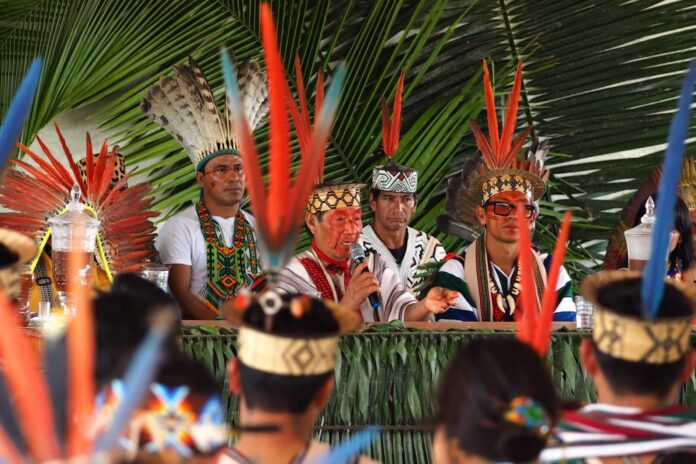Ayahuasca, a potent brew made from the Banisteriopsis caapi vine and Psychotria viridis leaves, has been integral to Amazonian indigenous cultures for centuries. Revered for its spiritual and healing properties, this sacred mixture is at the nexus of contemporary debates surrounding intellectual property, cultural heritage, and ecological sustainability.
A historical perspective on ayahuasca
Ayahuasca’s use dates back hundreds of years, with indigenous communities in Brazil, Colombia, Peru, and beyond integrating it into their spiritual practices. These rituals aim to connect participants with the spiritual realm, seeking guidance, healing, and inner clarity. For many tribes, ayahuasca ceremonies are crucial for shamanic training and holistic health practices involving diagnosis, treatment, and disease cure.
The knowledge associated with ayahuasca extends beyond its preparation and usage. It encompasses a broad understanding of the environment, as indigenous peoples rely on sustainable harvesting practices to maintain balance within their ecosystems. This profound interaction with nature ensures the continuing availability of the plants essential for making the brew.
Global recognition and its repercussions
In recent decades, ayahuasca has garnered interest outside indigenous circles, catalyzing global demand for this entheogenic tea. From urban centers to remote retreats in the Amazon, seekers from all over the world explore its purported benefits. This surge in popularity, however, raises critical concerns among indigenous leaders about the exploitation and commercialization impacts on both culture and ecology.
At the heart of this issue is the potential encroachment on indigenous intellectual property rights. Efforts to patent ayahuasca-related products by non-indigenous entities undermine the sovereignty of these communities over their traditional knowledge. Such actions provoke fears around the misappropriation of cultural assets, often without proper consent or benefit-sharing arrangements.
Conferences and councils: Indigenous responses to protection needs
The 5th Ayahuasca Indigenous Conference held in January at the Yawanawa’s sacred village exemplifies the mobilization against such threats. Delegates from 34 indigenous groups across several nations convened to address pressing issues concerning ayahuasca. The conference underscored the urgency of creating protective laws governing access, usage, and benefit distribution linked to ayahuasca.
One significant outcome was the agreement to establish a council of indigenous spiritual leaders. This council aims to formulate ethical guidelines for responsible ayahuasca use and research while advocating for greater female participation in leadership roles. This initiative marks a pivotal step towards ensuring that future engagements with ayahuasca honor indigenous traditions and perspectives.
Ethical research and collaborative practices
Another focal point is promoting ethical standards in scientific research involving ayahuasca. The consensus is clear: researchers must engage with indigenous communities through transparent consultations and secure prior informed consent. Moving forward, ethical collaboration should be the cornerstone of any investigation venturing into the realms of traditional medicinal knowledge.
This approach intends to mitigate exploitative tendencies and recognize the invaluable contributions of indigenous expertise. By incorporating local insights, scientists can enhance their understanding while supporting community well-being sustainably.
Balancing commercialization and conservation
The commodification of ayahuasca, particularly in Peru, has spurred an emerging form of spiritual tourism, where visitors partake in retreat programs featuring the brew. While these activities generate economic opportunities, they also pose significant environmental challenges. Overharvesting threatens the delicate balance maintained by native ecologies, raising alarms among indigenous activists about unsustainable extraction rates.
To counteract these risks, aligning commercial ventures with conservation principles is paramount. Initiatives promoting sustainable sourcing and cultivation practices can help preserve the natural habitats where ayahuasca plants thrive. Moreover, sharing profits with indigenous communities empowers them economically and incentivizes stewardship over their ancestral lands.
Ensuring the future sustainability of ayahuasca resources
Indigenous voices advocate for robust measures to safeguard ayahuasca’s future. They call for stringent regulations to cap extraction levels, coupled with educational campaigns to raise awareness of the ecological significance of responsible consumption. By fostering a collective respect for botanic resources, a balanced co-existence between human activities and natural preservation can be achieved.
This dual focus on cultural integrity and environmental sustainability encapsulates the broader vision of ayahuasca custodians. Emphasizing cooperation and mutual respect offers a pathway toward aligning modern uses of ayahuasca with the time-honored values held dear by its original guardians.
Diverse nomenclatures and traditions
Ayahuasca goes by various names within different Amazonian groups. Recognized as rami, kamarãpi, uni, huni, dispãnī hew, tsĩbu, yage, gaapi, and kahp hayakwaska, each term reflects the unique linguistic and cultural contexts of its users. Despite these differences, a shared reverence unites disparate tribes in their view of ayahuasca as a conduit to the spiritual world.
The ritualistic and practical dimensions of ayahuasca use demonstrate Indigenous resilience in maintaining their cultural practices amid external pressures. This adaptability illustrates how traditional knowledge systems evolve, safeguarding their relevance across generations densely intertwined with their environmental landscapes.
Future directions for ayahuasca management
Looking ahead, elevating indigenous leadership in the dialogue about ayahuasca’s role globally remains critical. Their insights and centuries-old wisdom provide a blueprint for managing this sacred plant responsibly. Collaborative efforts spanning legislative initiatives, ethical research frameworks, and sustainable business models can pave the way for a harmonious relationship between ancient traditions and contemporary demands.
Ultimately, acknowledging the centrality of indigenous sovereignty and environmental ethics will ensure that ayahuasca continues to be a source of spiritual enlightenment and physical healing for those who seek its mysteries.


